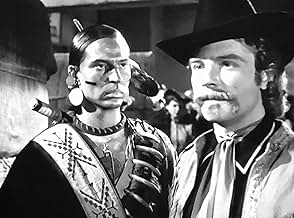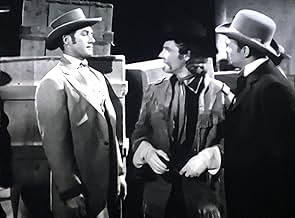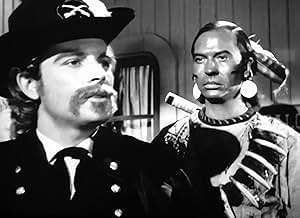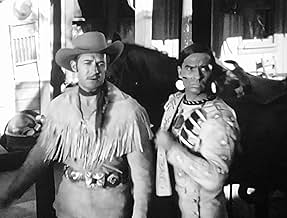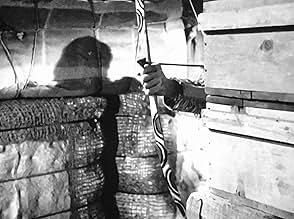An adventurer, gambler, and widely respected southern gentleman is recruited to work as a secret agent, at no pay, in post-Civil War New Orleans, helped by his companion, a silent Pawnee Nat... Read allAn adventurer, gambler, and widely respected southern gentleman is recruited to work as a secret agent, at no pay, in post-Civil War New Orleans, helped by his companion, a silent Pawnee Native American.An adventurer, gambler, and widely respected southern gentleman is recruited to work as a secret agent, at no pay, in post-Civil War New Orleans, helped by his companion, a silent Pawnee Native American.
Browse episodes
Featured reviews
I remember the show vividly; it was rerun on NBC afternoons later in the '60's. I live close to New Orleans, locale of the show, and met Mr. Mahoney at a rodeo the summer after the show ended. He was very friendly, let me hold his derringer, which was maybe not wise to do, told me where he bought it, etc. He stayed until the last autograph hound left. What really made the show was his athleticism with stunts, fights, falls, jumps, etc. One show had him trying to open a large box with his back to Pahoo; he made a gesture with his hand, keeping it up in the air shoulder height, and X Brands threw a large knife to Mr. Mahoney who caught it without looking. I read later that they thought it up as a gag, and decided to try it. It went on the first take. He became a stepfather to Sally Field, who seems to have had difficulties with him in that role, but he was really one of a kind in film. Later he had a stroke while horseback in "Kung Fu"; Burt Reynolds made a film about stunt men in the mid seventies with Brian Keith and Sally Field, the name of which I cannot remember, but it was a homage to stunt guys; Brian Keith's character had a stroke in the movie, reminding me of Mr. Mahoney; later, I read that Burt Reynolds said this was a bow to Mr. Mahoney. I was only 12, and got a kick out of the constant westerns at the time, but he gave it a distinctive feel. In TV Guide, he called it a "Southern". What was also interesting was his ensemble which came to include Mickey Morton, Lee Paul, Kelly Thorsen, etc. He was 6-4, and these guys topped him! Frances Bergen, Francine in the role, was wife of Edgar Bergen, whose daughter was Candice Bergen.
When I watched Yancy Derringer as a 6 year old, the guns were especially fascinating. Pahoo-Ka-Ta-Wah had a big shotgun, maybe 10 gauge. Yancy had several tiny guns that were hidden in his clothes. One in his hat, one in his boot. He could be searched, but still pull a derringer out of his sleeve. X Brands, as Pahoo-Ka-Ta-Wah, had the biggest shotgun I have every seen. As I recall, it had a single barrel with a mighty power. If needed, Pahoo-Ka-Ta-Wah could blast the bad guys with such force, smoke, kick, and noise, that it was the grand finale to any fight!
The derringers came in a variety of arrangements, with most of them having two barrels. But some may have had more than two. The smallest derringer had only one barrel. There was a trick derringer, if my memory as a boy serves me correctly. One trick derringer was up Yancy's sleeve on a spring-loaded mechanism. It had scissor shaped metal supports that would expand to full length on command of a gesture. The contraption would spring out of his sleeve into Yancy's hand into the right firing position. The gesture that triggered the spring to release was for Yancy to press his elbow against his side. One derringer was hidden in his belt buckle. Toy stores sold belts with hidden derringers after that show!
Pahoo-Ka-Ta-Wah would carry his shotgun with him wherever he went, but with poise and dignity which seemed non-threatening. X Brands' dispassionate face would seldom display any emotion. He spoke slowly and deeply, with somber meaning that always was important. Pahoo-Ka-Ta-Wah was tall and strong. In a fight, I only remember his 8 gauge shotgun: as the ultimate weapon in any New Orleans brawl. It could knock down a wall!
The derringers came in a variety of arrangements, with most of them having two barrels. But some may have had more than two. The smallest derringer had only one barrel. There was a trick derringer, if my memory as a boy serves me correctly. One trick derringer was up Yancy's sleeve on a spring-loaded mechanism. It had scissor shaped metal supports that would expand to full length on command of a gesture. The contraption would spring out of his sleeve into Yancy's hand into the right firing position. The gesture that triggered the spring to release was for Yancy to press his elbow against his side. One derringer was hidden in his belt buckle. Toy stores sold belts with hidden derringers after that show!
Pahoo-Ka-Ta-Wah would carry his shotgun with him wherever he went, but with poise and dignity which seemed non-threatening. X Brands' dispassionate face would seldom display any emotion. He spoke slowly and deeply, with somber meaning that always was important. Pahoo-Ka-Ta-Wah was tall and strong. In a fight, I only remember his 8 gauge shotgun: as the ultimate weapon in any New Orleans brawl. It could knock down a wall!
. . . they speak of Yancey D."
So went the theme song to this undeservedly short-lived series. Nominally billed as a "western" (Yancey did, after all, wear a broad-brimmed hat, there were horses about, and his best friend was an Indian), this show was hard to categorize, even in the era of the so-called "adult western."
There was always the hint of a dark side to Yancey, all things considered; a feeling that tucked away behind his reserved manner lay a past that may not always have been too cool (or, alternately, as a friend of mine once suggested, perhaps a bit TOO cool). Moreover, unlike most of his contemporary action heroes, Mr. D. didn't always fight fair: forced into a bare-knuckles match against an huge opponent, Yancey took advantage of his knowledge that the guy had spent the previous night guzzling beer, hammering him into collapse with a series of belly punches you could almost feel through the TV screen.
Not the nicest guy in town, in other words. But eminently effective. And thoroughly watchable. A great series.
So went the theme song to this undeservedly short-lived series. Nominally billed as a "western" (Yancey did, after all, wear a broad-brimmed hat, there were horses about, and his best friend was an Indian), this show was hard to categorize, even in the era of the so-called "adult western."
There was always the hint of a dark side to Yancey, all things considered; a feeling that tucked away behind his reserved manner lay a past that may not always have been too cool (or, alternately, as a friend of mine once suggested, perhaps a bit TOO cool). Moreover, unlike most of his contemporary action heroes, Mr. D. didn't always fight fair: forced into a bare-knuckles match against an huge opponent, Yancey took advantage of his knowledge that the guy had spent the previous night guzzling beer, hammering him into collapse with a series of belly punches you could almost feel through the TV screen.
Not the nicest guy in town, in other words. But eminently effective. And thoroughly watchable. A great series.
Yancy Derringer was different from all other westerns on the air during the late '50's in that it was set in New Orleans rather than a dusty old west town. Yancy Derringer, as played by former stuntman Jock Mahoney, did not carry the traditional six shooter, he packed a pistol in his hat. Yancy Derringer was a dapper, smooth, suave gambler who, along with his Pawnee Indian companion Pahoo, assisted Commissioner John Colton in keeping the peace in a wide-open city.
Yancy Derringer had a different "feel" to it as compared to the other westerns on the air during the later '50's and was a very welcome change during its too short one season run on CBS.
Yancy Derringer had a different "feel" to it as compared to the other westerns on the air during the later '50's and was a very welcome change during its too short one season run on CBS.
This was another good western back in the '50s which gives me fond memories. I remember how me and my pals thought this hero was "cool," something like Richard Boone was in "Have Gun, Will Travel."
The main differences in this western as opposed to most was that the title character
packed a little derringer in his hat, and the setting was New Orleans instead of the old west. Otherwise, he was, like Boone's "Paladin" a smooth, dapper and cool customer.
Jock Mahoney ("Yancy Derringer") was the rugged, silent type, if I remember correctly. The shows were very interesting and we looked forward to them each week. Why this show only lasted on year is a real mystery to me. I don't remember anyone who didn't enjoy it. The mid-to-late '50s was a fabulous era for westerns on TV. If this ever came out on DVD, I would buy it immediately.
The main differences in this western as opposed to most was that the title character
packed a little derringer in his hat, and the setting was New Orleans instead of the old west. Otherwise, he was, like Boone's "Paladin" a smooth, dapper and cool customer.
Jock Mahoney ("Yancy Derringer") was the rugged, silent type, if I remember correctly. The shows were very interesting and we looked forward to them each week. Why this show only lasted on year is a real mystery to me. I don't remember anyone who didn't enjoy it. The mid-to-late '50s was a fabulous era for westerns on TV. If this ever came out on DVD, I would buy it immediately.
Did you know
- TriviaThe decaying Southern mansion seen on the series was the Tara set from Autant en emporte le vent (1939), which stood on the back lot at Desilu Studios (formerly Selznick International Pictures). The facade was sold and moved to Georgia in 1959.
- ConnectionsFeatured in TV's Western Heroes (1993)
- How many seasons does Yancy Derringer have?Powered by Alexa
Details
- Runtime
- 30m
- Color
- Sound mix
- Aspect ratio
- 1.33 : 1
Contribute to this page
Suggest an edit or add missing content


